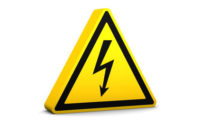FR Protection
Assessing arc flash risk

ISHN spoke to Colin Duncan, CEO of the SEAM Group, and Jay Smith, SEAM Group director safety services, about arc flash hazard analyses (AFHA).
Why do many companies misunderstand the level to which AFHA should optimally be done? Companies who have not kept up with the changes in NFPA 70E are typically not versed in the requirements.
Many companies rely on local resources they have trusted with electrical repairs, or contractors who help them with facility construction to guide them in how to approach electrical safety. Often times the resources they trust are not electrical safety experts. We often see that it is merely lack of education on what is required to protect employees from electrical hazards that can cause varying levels of AFHA.
Why does this misunderstanding lead to assets being overlooked and not properly assessed?
Again, lack of education on the capability of equipment to produce an arc. We see many companies adopting the notion that only 480V equipment can cause a significant arc and thus only that type of equipment needs assessed. This leads to the belief that any downstream items cannot have a higher hazard than their upstream feed. This is simply not true and something of a myth.
How common is it for workplaces to be unaware of an AF risk?
Very common. Although it's not that workplaces assume there isn't a risk, it's just to what level could it be. With shock hazards it is easy, if you can reach in and touch the "shiny parts" you can get shocked. With arc flash its more difficult to determine what equipment has higher arc flash hazards.
Why do arc flashes often occur from minor oversights?
Typically minor oversights can be common equipment, or equipment that is serviced or interacted with frequently. It can often be that this frequent interaction/exposure increases the likelihood that an arc flash may occur.
Why do companies fail to effectively identify and inventory AF risk factors?
This gets back to relying on local resources that are not electrical experts, and the lack of education and awareness on the capability of equipment to product an arc. And again, a company needs someone qualified to do the work, which requires technical knowledge that is often lacking
What hazards are most typically often overlooked?
Branch circuits, downstream items like disconnects, RTUs on roof tops, even control cabinets. We see many times that facilities will assess the main gear and even down to the MCC level and then stop. It's the assumption that a downstream little 30A disconnect can't have a hazard greater than its upstream feed. This is just not true and often leads to a misguided approach to an arc flash. Dust can be a big hazard and even cause arc flash when equipment is operated where "fugitive" dust is present. Rusted doors, hinges, missing knock-outs, screws, etc. are all signs of deteriorating equipment that cause additional hazards.
Do most companies have qualified personnel to assess the likelihood that an adverse event may occur, and the severity of the injury if it does?
Not typically.
What to assess
Arc flashes often occur from minor oversights, so an ideal arc flash hazard assessment should consider a number of risk factors that might not be immediately obvious. These include: the presence of dust and condensation within or on an electrical asset; accidental contact with an asset due to poor training or lack of signage; the mishandling of tools resulting in conductive items left near live assets; the presence of condensation within electrical assets; and electrical asset corrosion and faulty installation.
|
Steps to complete an arc flash analysis From a blog post by Jeson Pitt on the Voluntary Protection Programs Participants Association website Data collection: Collect necessary data about the facility’s power distribution system. Data includes the details of the arrangement of components on a one-line drawing and nameplate specifications of every device. The lengths and cross-section of all cables are also included. Engineering analysis of the data: Perform a short circuit analysis followed by a coordination study. Feed the resultant data into the equations described by NFPA 70E-2000 or IEEE Standard 1584-2002. These equations produce the necessary flash protection boundary distances and incident energy to determine the minimum PPE requirement. Protective device coordination: Perform protective device coordination to ensure selection and arrangement of protective devices to limit the effects of an overcurrent situation to the smallest area. Use results to make recommendations for mitigating arc flash hazards. Arc flash calculations: Determine the incident energies and flash protection boundaries for all equipment. Incident energy is the energy needed for an arc flash to cause second-degree burns and flash protection boundary is the distance where the incident energy or second-degree burns are caused. Arc flash study and analysis report: Prepare the arc flash report, which provides a short review period during which your team can evaluate modifications. Label installation: Create and install arc flash warning labels which pinpoint incident energy and working distance, arc flash boundary, and nominal system voltage. |
Source:
1. https://www.vpppa.org/symposium/blog-entry/conducting-arc-flash-risk-assessment-for-employee-safety
Looking for a reprint of this article?
From high-res PDFs to custom plaques, order your copy today!








